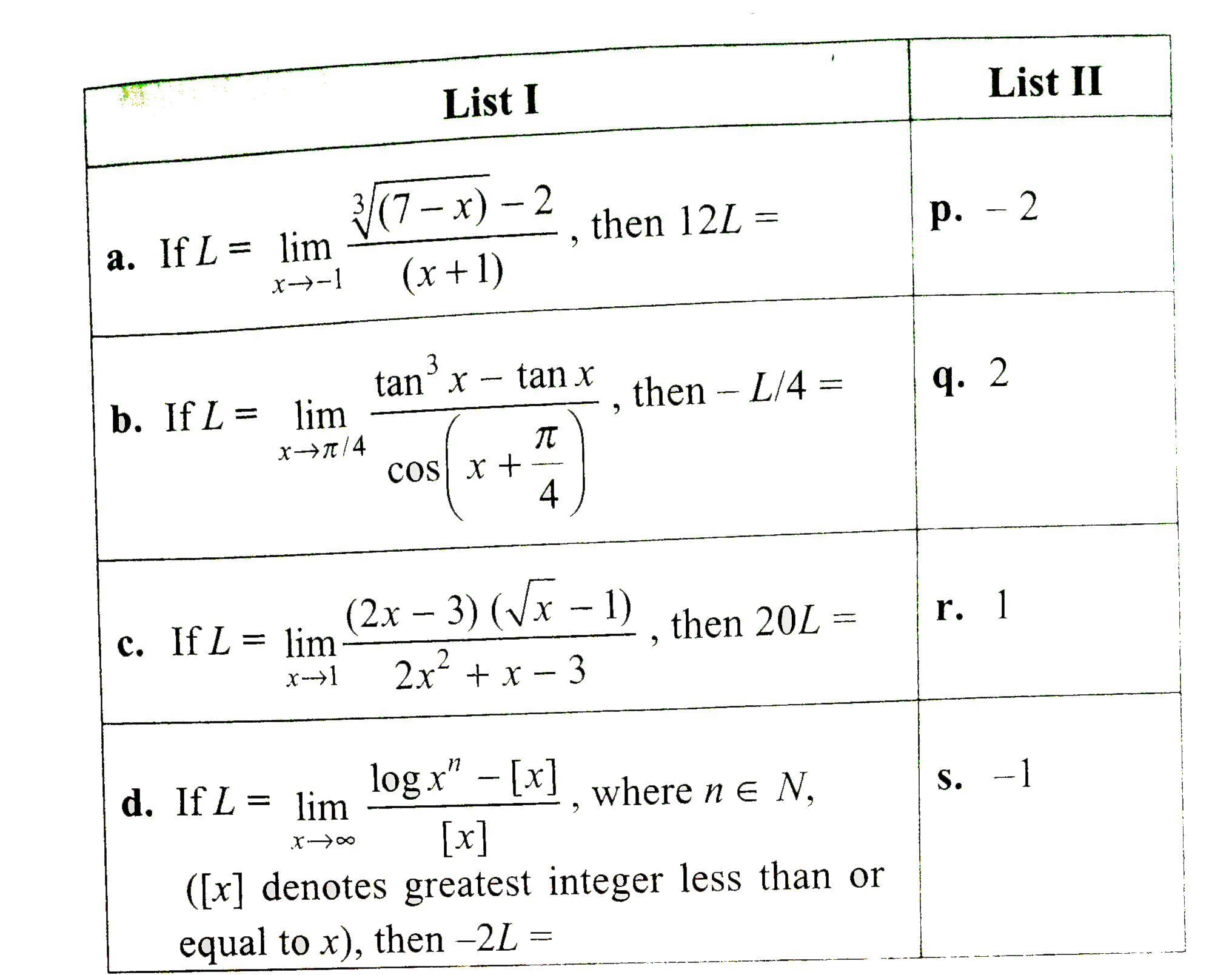If (lim)x→1−(2−x+a[x−1]+b[1+x]) exists, then aandb can take the values of (where [.] denotes the greatest integer function). (a)a=13,b=1 (b) a=1,b=−1 (c) a=9,b=−9 (d)a=2,b=23Solution in Tamil
The correct Answer is:B, C
Since the greatest integer function is discountinuous at integral values of x, for a given limit to exist both left-and right-hand limits must be equal.
L.H.L.=limx→1−(2−x+a[x−1]+b[1+x])
=2−1+a(−1)+b(1)=1−a+b
R.H.L.=limx→1+(2−x+a[x−1]+b[1+x])
=2−1+a(0)+b(2)=1+2b
On comparing, we have −a=b.
Topper's Solved these Questions
- BOOK - CENGAGECHAPTER - LIMITSEXERCISE - Exercise (Comprehension)20videos
LIMITS
- BOOK - CENGAGECHAPTER - LIMITSEXERCISE - Exercise (Matrix)5videos
LIMITS
- BOOK - CENGAGECHAPTER - LIMITSEXERCISE - Exercise (Single)76videos
LIMITS
- BOOK - CENGAGECHAPTER - JEE 2019EXERCISE - Chapter 109videos
JEE 2019
- BOOK - CENGAGECHAPTER - LINEAR COMBINATION OF VECTORS, DEPENDENT AND INDEPENDENT VECTORSEXERCISE - DPP 1.210videos
LINEAR COMBINATION OF VECTORS, DEPENDENT AND INDEPENDENT VECTORS
Similar Questions
Find the domain of f(x)=√|x|−{x} (where {⋅} denots the fractional part of x).
03:17View SolutionMatch the following lists:
 06:12View Solution
06:12View Solution(lim)x→0[sin(sgn(x))(sgn(x))], where[.] denotes the greatest integer function, is equal to (a)0 (b) 1 (c) −1 (d) does not exist
06:44View SolutionIf y = y(x) is the solution of the differential equation, xdydx+2y=x2 satisfying y(1) = 1, then y(12) is equal to
01:51View SolutionThe number of integral values of p for which (p+1)ˆi−3ˆj+pˆk,pˆi+(p+1)ˆj−3ˆk and −3ˆi+pˆj+(p+1)ˆk are linearly dependent vectors is q
01:57View Solution(lim)x→∞{x3+1x2+1−(ax+b)}=2,then (a)a=1,b=1 (b) a=1,b=2 (c)a=1,b=−2 (d) none of these
12:35View SolutionIf (lim)x→1−(2−x+a[x−1]+b[1+x]) exists, then aandb can take the values of (where [.] denotes the greatest integer function). (a)a=13,b=1 (b) a=1,b=−1 (c) a=9,b=−9 (d)a=2,b=23
03:25View Solutionlimx→−7[x]2+15[x]+56sin(x+7)sin(x+8)= (where [.] denotes the greatest integer function) a. is 0 b. is 1 c. is -1 d. does not exist
03:34View Solution(lim)x−−−−→−1−31x[−1x]= (where [.] denotes the greatest integer function) a. -9 b. -12 c. -6 d. 0
01:38View Solution(lim)x→0[sin−1xtan−1x]= (where [.] denotes the greatest integer function) a. 0 b. 1 c. -1 d. none of these
02:55View SolutionIf the solution set of [x]+[x+(1)/(2)]+[x-(1)/(3)]=8 is [(a,b) then (a+b) equals (where [1 denotes greatest integer function)
04:15View SolutionIf f(x)={ax3+b, for 0≤x≤1and2cosπx+tan−1x, for 1<x≤2 be the differentiable function in [0,2], then find aandb, (where [.] denotes the greatest integer function).
04:11View SolutionIf x^(4)+1+4cos(ax^(2)+b)=2(x^(2)-2) and a,b in(0,2), then (a+b) equals (where [.] represents the greatest integer function )(A)0 (B) 1(C)2(D)3
04:26View SolutionIf x−1x=3 , then the value of 1+1x2 is (a) 9 (b) 10 (c) 11 (d) None of these
04:51View Solution(3x^(2)-8x+9)/((x+1)^(3))=(a)/(x+1)+(b)/((x+1)^(2))+(c)/((x+1)^(3)), then a+b+c=
03:56View SolutionIf limx→1(3−x+a[x−1]+b[x+1]) exists (where [ ] denotes the greatest integer function),then value of a+b
02:27View Solution

